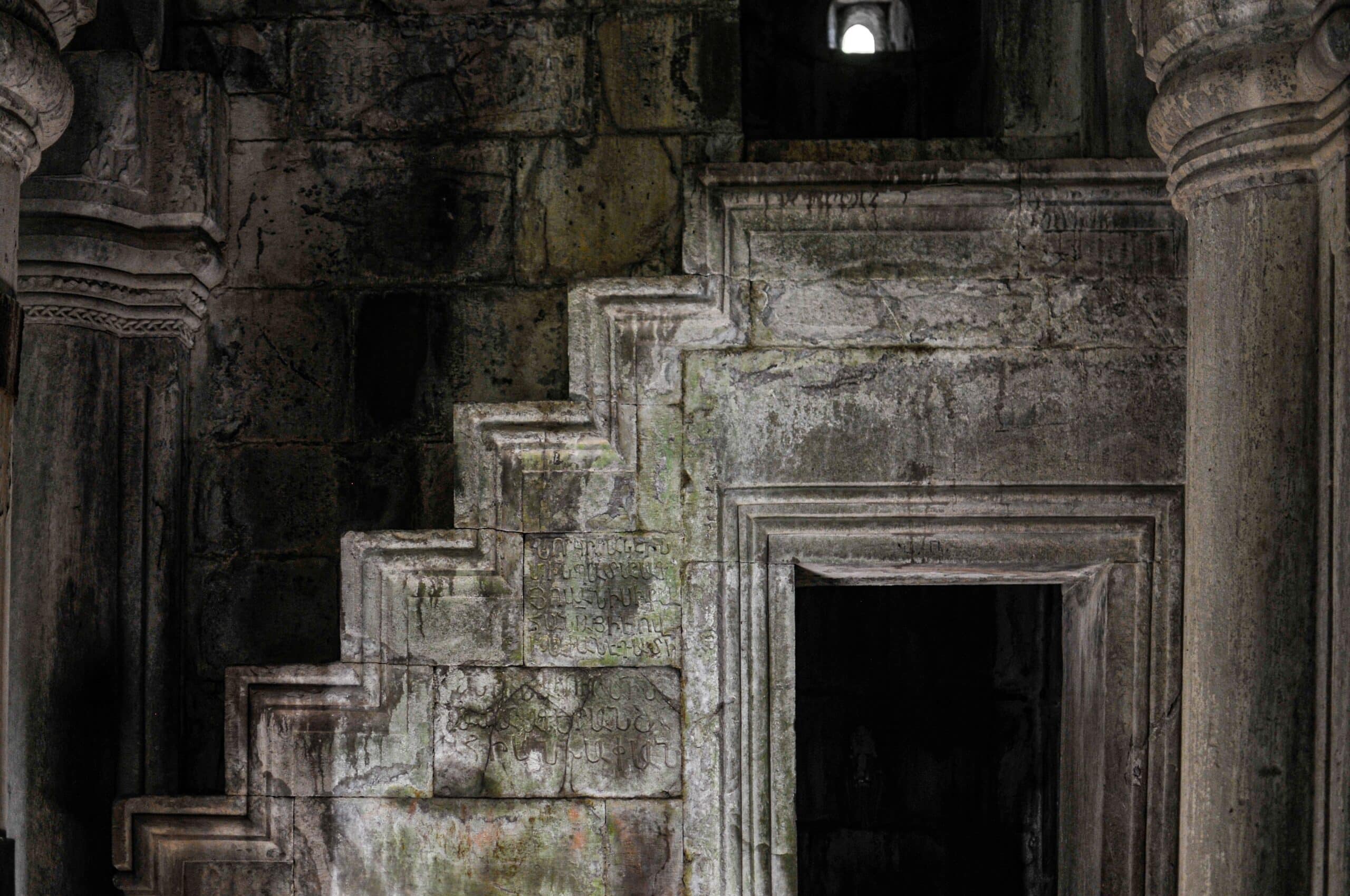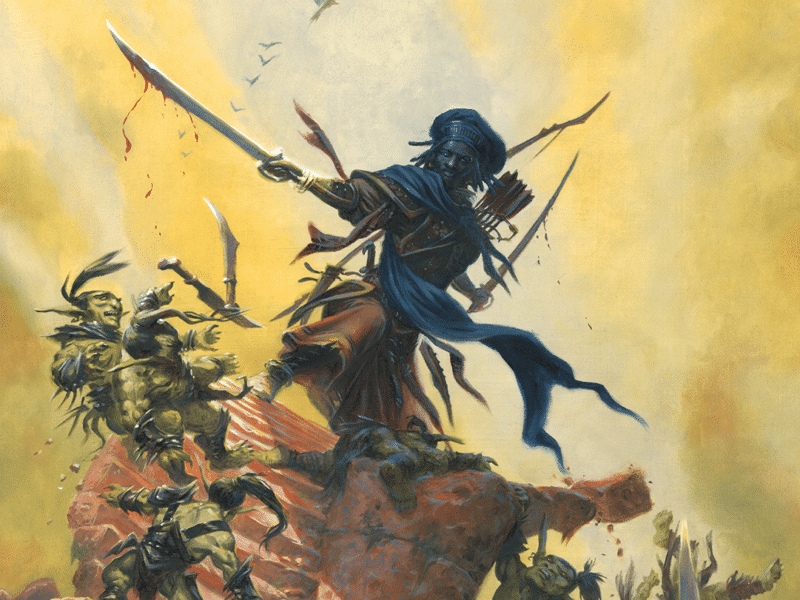In this article, we’ll take an in-depth look at how to run fun, exciting, and engaging adventures in what arguably is the most common environment of Dungeons & Dragons: The Dungeon! So light your torches, open your spellbooks and draw your blades as we enter the darkness to find what tips and tricks you can spring upon your players!

Ah, dungeons! How many adventures aren’t set in tunnels, caverns, and grottos filled with treasure, hordes of critters, and the odd ferocious dragon? The image of a group of adventurers who, swords and torches in hand, are wandering into the dark is possibly the most archetypal fantasy motif imaginable. That’s no wonder, seeing how myths and fairy tales are packed with stories of wealth and danger awaiting underground.
And Dungeons & Dragons, with its feat-based combat system and huge range of subterranean monsters, is very much about finding terrible creatures beyond sunlight and sticking your sword in them (or blasting them to smithereens with your spells, or peppering them with arrows, or impaling them upon your lance – you know what I mean). Half of the title of the game is dungeons, after all!
But no two dungeons are alike, and there’s a variety of ways to make sure that your next one will be a place to remember. Because with a few simple tweaks, it is possible to turn a handful of simple corridors and rooms into a dungeon that will make a great impression on your players, and that they won’t forget.
The size
Let’s start with one of the most fundamental considerations when building and populating a D&D dungeon: its size. The official D&D adventures offer a great variety of dungeons that range from tiny – for example, three rooms and a few nooks – to massive complexes that span tons of room, multiple levels, and 10 or more character levels (yes, Dungeon of the Mad Mage, I’m looking at you).
Drawing dungeons is fun, and coming up with ideas for what’s inside them is even more entertaining, so it’s often tempting to fill entire pads with mazes and a thousand different rooms. And there’s absolutely nothing wrong with that! But it’s worth bearing in mind that dungeons tend to be full of encounters – monsters, traps, puzzles, riddles, obstacles, and so on – and all of these take time. In fact, some of them might take much longer than one would expect! Many DMs have experienced the strange phenomenon when an adventuring party for some obscure reason decides that a certain door or opening looks suspicious, and abruptly stops their progress to discuss their marching order for half an hour. In a dungeon, which effectively is a collection of collected openings, such pauses can result in hours of gaming time lost.
So unless you’re used to running large dungeon-based adventures, I’d recommend that you start with a small one. A dungeon that features five or six larger rooms, and which has around three to five monster encounters, maybe a trap and a hazard or two, and some kind of challenge in the form of a puzzle can easily keep a group of players occupied for an entire session.
Another potential issue to consider is that of repetition. A huge and flat dungeon, in which all the rooms are similar in style and lack distinct features, can quickly become monotonous and, even worse, boring. Even if its various spaces hold monsters of every type in the Monster Manual, the game risks becoming a matter of stats and rolls – and not so much about a sense of adventure and excitement.
This is easily avoided by adding in things that make the dungeon feel more alive, dynamic, mysterious, and real – and we’ll touch on many such ideas here below.
History and purpose
Next up is thinking about the reason why the dungeon exists in the first place. There are a few classic origins, one of which is the dungeon that’s been created as a challenge. Typically, it’s been made by a powerful individual – often a mage – in order to provide truly worthy heroes with a reward. The creators are commonly either long gone, or they are waiting for the adventurers at the end (usually in the shape of a challenge).
There’s also the large crypt, and it’s easy to see why these make for great dungeons: they’re underground, they’re the final resting place of people who might’ve been buried along with their riches, and they’re damned scary – especially in a world in which dead people might not be entirely dead.
But there are many other ways that a dungeon might come into being. For a start, there are natural caves that can form sprawling complexes, even if they haven’t been altered in any way. These can be inhabited by all kinds of creatures – humanoids, monsters, or both – which make their homes in the spaces and use them for a variety of purposes. These dungeons are often rich in natural features, and frequently include challenging passages. They can also be quite risky to explore, with slippery floors and sudden drops – and, of course, deadly stalactites waiting to snap and fall at the wrong moment!
There are also large locations such as grand temples, huge libraries or even entire settlements that may be constructed inside a mountain or below the ground, for the sake of safety, secrecy, or convenience. Some of these may have been abandoned for one reason or another, and this way become populated by other creatures or monsters, which make them perfect foundations for good dungeons.
So spend a few minutes coming up with an explanation for why your dungeon-in-the-making came to be. Once you’ve decided on its origin, you’ll probably find that you start having ideas for how it looks and what it contains. By and large, this determines the dungeon’s theme – and themes are great, as they create a sense of coherence and realness, and avoid the head-scratching bewilderment that often accompanies total randomness.
The effect of time
Now that you know the original reason for why your dungeon exists, there are a few more things to consider that will affect its look and feel: how long ago was it created, and how much time has passed since it became a dungeon – in other words, if it has been abandoned or otherwise turned into a place that the adventurers can visit, when did this happen?
For example, let’s say that you’ve decided that your upcoming dungeon will be a former temple dedicated to the deity of the moon. This temple was constructed roughly a thousand years ago with great care, and filled with elaborate carvings and artwork in honour of their god? Then perhaps the temple was overrun by orcs around a hundred years ago, and the inhabitants were forced to flee. Since that time, the invaders and their followers have control of the complex, and have redecorated its spaces to their own tastes and requirements.
All of these factors can be hugely helpful when writing the descriptions of the various rooms. Even if you don’t want to have custom descriptions for every space in the dungeon, you can still use the idea for the background to sprinkle in a few sentences at the start of the session:
“As soon as you enter the temple, you see crumbling statues and fading carvings that portray people offering gifts and praying to the moon. They look at least a thousand years old, and they must’ve been beautiful once. However, the serenity of the temple is marred by the presence of big crates filled with dried ham, kegs of ale, and sacks full of equipment, most of which have labels in Orc. These too are old, and judging by the spiderwebs that hang between the crates, they’ve been untouched for centuries.”
With just a few sentences, you’ve created a sense of history behind a location – the impression that time has passed here, and that those who have made their home in the halls have spent considerable time in them.
Functionality
Now that you’ve figured out who have lived in the temple, it’s a great time to start deciding how its spaces were used and the design was planned. Just as a dungeon is more engaging and atmospheric if it has had a purpose, or at least some reason for existing beyond an unhinged spellcaster’s whim, each room in it will come across as more tangible and interesting if it makes sense.
For example, the temple might have a central large room used for common prayers and contain furniture that represents this activity. There could be smaller rooms for special ceremonies, bedrooms for clerics who were present at the temple at all times, and an armoury next to a guards’ dorm for those who are tasked with defending the area. There might be stairs that are used frequently or for important events, and therefore are wide and centrally located, while the other stairs are smaller and less ornate.
Similarly, adding in a few spaces that the occupants or builders might have found useful will add to the sense of realness of the dungeon. Such spaces include storages, bathrooms, kitchens, larders, rear entrances, corridors and rooms designed mainly for staff, and hidden chambers.
Natural features
Additionally, there might be areas where the original underground elements are displayed, either on purpose or by accident. For example, there could be a site within the temple where the builders have left a subterranean spring untouched for decorative reasons or out of the belief that it is sacred. There might be a fissure between two rooms that was too deep to be filled, so a bridge has been installed to allow passage. Or maybe there’s a room that is filled with a rare plant that thrives away from sunlight, which the clerics once used for relaxation but which now is wildly overgrown.
These features are likely to be more common if a lot of time has passed since the dungeon was built and, more importantly, abandoned. If no one has been around to maintain the stonework, some tunnels may have caved in, walls may have cracked due to tremors in the bedrock, and water may have pooled where a slow dripping has been left unchecked for years on end.
Multiple levels
Another simple way to create a dungeon that’s intriguing is to let it have more than one level. There’s a ton of D&D dungeons out there that are, effectively, flat, with only one floor on which everything is situated. Of course, there are some practical reasons for this: if you draw up a dungeon on a paper, adding stairs, ducts, pits, ladders and other features that allow the adventurers to venture onto other floors can be tricky and cause lots of swapping maps back and forth. However, a dungeon doesn’t need multiple levels that are equally large – a main floor with a few places located up or down will suffice, and you can use separate maps for each one of them.
There are great benefits to doing this. One is that the dungeon will feel more genuine, as it’s probable that the builders would have made at least a few spaces situated above or below the main dungeon. Another is that as soon as the players spot the first space that’s accessed through a staircase or a hole, they will start to be on the lookout for more such passages – in other words, the dungeon suddenly becomes more engaging and less predictable. Last but not least, there’s a subtle psychological effect that kicks in when the characters, who already are in a dungeon, must go even farther down. The idea of being underground usually makes most people vigilant for threats, and it’s no different when playing a roleplaying game: when the characters are forced to proceed deeper down, the tension will rise.
Traps
A common feature in dungeons is traps that have been set by the constructors to deter or slay intruders. However, I would suggest that if you want to add a few traps to our imagined temple-like dungeon, spend a minute considering why they’re there, and what they’re designed to do. If a trap is meant to prohibit access to a certain area, it will probably include a steel door that slams down rather than a hail of poisoned darts fired through concealed holes in a wall. Conversely, a trap that’s meant to kill the creature that triggers it will most likely be created to target an area with lots of damage.
What’s more, don’t hesitate to be creative with traps. There’s a plethora of good ideas on the internet so look around for inspiration. One quick tip is to let traps escalate by following a small initial complication, such as a single poisoned arrow, with increasingly bigger problems that are set in motion the following round). In other words, a trap can keep going for several rounds with more and more detrimental effects.
I also strongly recommend letting the adventurers encounter a trap that’s already been sprung. This could for example be a skeleton hanging from a row of spears that protrude from a wall. Such an encounter has multiple effects: skeletons are naturally unnerving, and the players will immediately start to worry about other traps that haven’t been sprung yet.
Monsters
Just as traps should make sense, the same is true for monsters – each and every one of them needs a reason for being where it is. This being Dungeons & Dragons, it’s easy to argue that monsters can have teleported into rooms or conjured there by magic means, and there’s nothing wrong with that. However, sprinkling in random monsters will do little to help your dungeon feel authentic and exciting – on the contrary, if the players fight a haphazard gallery of creatures that are unrelated to the general feel of the dungeon, they’ll soon feel like they’re in a bizarre funhouse in which anything might happen. While surprises are good, this kind of arbitrariness is a ticket to boredom.
Instead, populate your temple with creatures that have a solid reason for having found their way there. There might be snakes that have been attracted by the presence of suitable nesting places, ghosts that have risen from the tombs of high-level clerics, spiders that have spun huge webs in abandoned storage spaces with small windows through which bugs keep flying, and so on.
There might also be totally unexpected encounters in the temple! For example, a bear that’s wandered in there by mistake recently and can’t find its way out, but which has discovered a huge repository of honey pots that it can eat to stay alive. Or an assassin with a price on their head who has chanced upon the temple and hides there while waiting for their followers to lose the trail.
Darkness
Lastly, a dungeon should be dark. Because of the prevalence of darkvision and spells that provide illumination in the most recent edition of Dungeons & Dragons, it’s rare that darkness becomes an actual obstacle. However, I propose that you, being the DM and thereby in the possession of mighty powers, tweak these rules, either only for a specific place or – even better – for all your games. For example, part of a dungeon could be filled with magical darkness in which normal darkvision doesn’t work and torches have reduced effect.
Alternatively, consider scrapping darkvision altogether. Just get rid of it and replace it with some other small benefit, such as a few more hit points or another proficiency. Your players might not thank you, but your adventures will suddenly feel a lot more thrilling!
Those were the ideas and tips that I had for this time! Hopefully, you’ve found one or two that will make your sessions even more tense, creepy, and thrilling for your players! Remember that a dungeon is a flexible location, so let only your imagination set the limits. And never forget that darkness is your friend – and the characters’ worst enemy!







